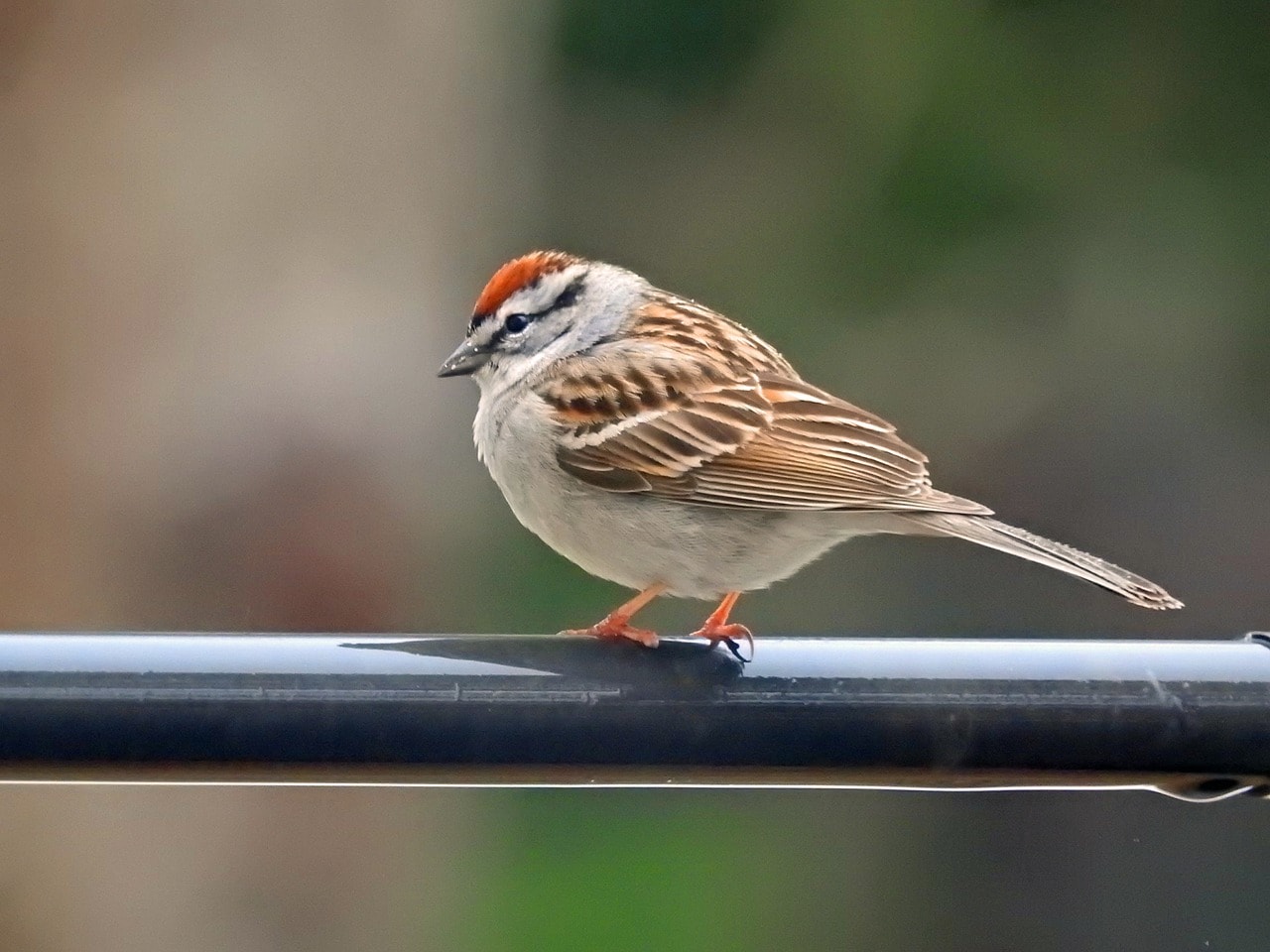Chipping Sparrow: Field Guide, Pictures, Habitat & Info
Last Updated on

The Chipping Sparrow, like most Sparrows, is a small, active, and intriguing bird. It’s rather easy to identify from other species thanks to the splash of orange-red on the top of its head. Other than that, however, it doesn’t stand out particularly well, at least physically. Chipping Sparrows have a recognizable song, which is quite loud for such a small bird. The songs of Chipping Sparrows are one of the most common you’ll hear when walking in the woods looking for birds to enjoy. If you’re keen on discovering all you can about the delightful Chipping Sparrow, including where they live, how they mate, what they eat, and more, read on. We have all the information waiting for you below!

Quick Facts about the Chipping Sparrow

| Habitat | Open woodlands, orchards, suburban areas, farms |
| Diet | Seeds, small fruits, invertebrates |
| Behavior | Ground foragers |
| Nesting | Open cup nests in conifer trees and shrubs |
| Conservation | Low Concern (LC) |
| Scientific name | Spizella passerina |
| Lifespan: | 5 to 9 years |
Chipping Sparrow General Description
One of the distinguishing traits of the Chipping Sparrow is the tuft of bright, reddish-orange feathers on the very top of its head that makes it look like it’s wearing a red beanie. Adult male Chipping Sparrows have a jet black beak with a black streak flowing past their small, black eyes.
They also have a streak of white and black down the front of their head intersecting with their beak. Their flying feathers are a combination of brown and tan with horizontal white streaks, including their slightly darker tail feathers. Their neck and belly are an off-white color, and they sit on short, pale orange legs with long, pale orange toes. Male and female Chipping Sparrows are very similar in appearance, with minimal sexual dimorphism.
Chipping Sparrow: Range, Habitat, Behavior, Diet & Nesting
Range
The Chipping Sparrow can be found almost everywhere you look in North America, from Canada and Alaska down to Mexico and Central America. However, you won’t find many in Florida or the Great Plains, as the heat and humidity can be too much for them.
Habitat
Open woodlands are where you’ll typically find Chipping Sparrows, and they also love apple and other fruit orchards. They can easily make a home in urban and suburban areas and also have a fondness for farms and pastureland with a scattering of trees.
Behavior
Being ground feeders and foragers makes it easy to spot Chipping Sparrows, and, compared to most birds, they’re relatively tame. These tiniest of the Sparrow species like to hop around on the ground and fly short distances very rapidly. They are most active in the morning and early evening but can be seen throughout the day.
They like bathing in shallow streams and bird baths if given the opportunity. If the food on the ground is scarce, they will forage in shrubs and bushes. Chipping Sparrows migrate but not exceptionally far, usually from the northern parts of North America to the southern parts, but only as far as needed to escape the cold. Like most Sparrows, Chipping Sparrows will gather together in flocks to forage and are relatively social birds.
Diet
Although their diet varies with the seasons, Chipping Sparrows mostly eat seeds and grasses with the occasional herb and small fruit thrown in for good measure. During their mating season, Chipping Sparrows eat more insects, likely for the nutrients they provide. They are considered herbivores, granivores, and graminivores.

Nesting
A mating pair of Chipping Sparrows will choose the site where they will make their nest together. Nests are built by the female Chipping Sparrow and are typically between 3 to 10 feet off the ground. They build a “cup” nest with various materials, from feathers and fur to twigs, rootlets, and animal hair.
Chipping Sparrows use so much horsehair to build their nests that they’re often called “hair birds.” Males usually find food and give it to the female to pass to their nestlings. A male Chipping Sparrow sometimes has more than one mate. Some conservationists believe that the species is more polygynous than monogamous.

How to Find Chipping Sparrows: Birdwatching Tips
What To Listen For
The common call of the Chipping Sparrow is a very fast chirp that’s high-pitched and loud. In fact, they are called Chipping Sparrows because of the sound they make when they vocalize, which sounds like they’re saying “chip!” It is piercingly loud and one of the easiest determiners when you’re trying to identify this species.
What To Look For
The most notable feature of the Chipping Sparrow is the splotch of orange-reddish color on the very top of their head, which sets them apart from other Sparrow species. The black line that seems to go through their eye is also a dead giveaway, and so is their off-white underbelly with no streaks. Also, look for small flocks of Chipping Sparrows on the open ground feeding on seeds and bugs.
When To Look
Although active most of the day, the best times to see Chipping Sparrows are in the early morning and later afternoon. They will usually be on the ground running and hopping around like mad, and making short, quick flights from one area to another close by. Look for them in short bushes and shrubs as they search for insects. During mating season, you’ll spot male Chipping Sparrows in higher tree branches as they look for mates.

Attracting Chipping Sparrows to Your Backyard: Tips & Tricks
There are several methods you can use to attract Chipping Sparrows to your backyard. The good news is that they are probably already there, so getting them to gather around so you can enjoy them shouldn’t be a problem. Some of the best tips and tricks to attract Chipping Sparrows to your backyard include:
1. Bird Baths
Like most Sparrows, Chipping Sparrows love a good bath in a shallow pool of water, which makes large, shallow bird baths perfect for attracting them. Put your birdbath where there are some shrubs and bushes to give them extra protection. Also, make sure the bath is low or on the ground, as Chipping Sparrows prefer to stay low while bathing, eating, etc.

2. Food Scattered on the Ground
Chipping Sparrows are ground foragers for the most part, so scattering food they like on the ground is the best method to get them to come and visit.
- Millet
- Peanut hearts
- Scratch feed
- Cornbread
- Crushed pecans
- Mealworms
3. Bird Feeders with Feeding Trays
Although mostly ground foragers, Chipping Sparrows will fly a few feet off the ground to get to something yummy. That makes bird feeders with feeding trays a great method to attract them, as well as hopper feeders.

4. Plant Ornamental and Native Grasses
As we’ve learned today, Chipping Sparrows eat mostly grass seeds. Growing native and ornamental grasses in your yard is a great idea to attract them. The grasses will give them plenty of seeds to eat and allow them to stay hidden from predators at the same time (especially your local neighborhood cats). Switch grass, redbud, and prairie drop seed grasses are best.
5. Give them Nesting Materials
We know that Chipping Sparrows use a variety of materials for their nests, especially horsehair. If you want to attract them to nest, leave nesting materials around your yard, including horsehair (if you can find some), pet hair, small twigs, grasses, fine string, and so forth.
6. Hang a Nesting Box
Some Chipping Sparrows will gladly take advantage of a nesting box in your yard. It should be rather low to the ground but not too low that cats can cause problems. Leave nesting materials nearby to give them more of an incentive to use the box as their temporary home.
Chipping Sparrow Conservation: Is this Bird Threatened?
The good news about Chipping Sparrows is that, although they were in trouble a few decades ago, their numbers have steadily risen. Today, the Chipping Sparrow population is very strong and classified as LC, the lowest concern. One reason is that Chipping Sparrows are very adaptable and can live in a range of habitats and conditions.
You’ll find them living on orchards, farms, and suburban towns, among other locations. Another is that this Sparrow species produce offspring at a relatively prolific rate, as the male will pair with several females simultaneously (but in different areas). One last reason is that Chipping Sparrows can produce two broods every breeding season, while many bird species only produce one.
The biggest threat to Chipping Sparrows? Unfortunately, most are human-made, including pesticides, large buildings that they crash into when migrating, and electrical and Wi-Fi towers. Maybe the biggest threat, however, is outdoor house cats.

Final Thoughts
As one of the smallest Sparrow species, the Chipping Sparrow is also one of the easiest to identify, thanks to the splash of red and orange color on the top of its tiny head. They like to stay close to the ground when foraging for food and eat mostly seeds and insects, although they won’t pass up small fruits if they can find them. Chipping Sparrows are polygynous, raise their young together, and are prodigious breeders that will raise two broods a season.
We hope you enjoyed today’s close look at the Chipping Sparrow and our info-packed field guide. Best of luck spotting the tiny birds with the red caps in your yard or woods.
Featured Image Credit: magaliiee13, Pixabay
Table of Contents
- Quick Facts about the Chipping Sparrow
- Chipping Sparrow General Description
- Chipping Sparrow: Range, Habitat, Behavior, Diet & Nesting
- How to Find Chipping Sparrows: Birdwatching Tips
- Attracting Chipping Sparrows to Your Backyard: Tips & Tricks
- Chipping Sparrow Conservation: Is this Bird Threatened?
- Final Thoughts
About the Author Greg Iacono
Greg Iacono is a self-taught writer and former chiropractor who, ironically, retired early due to back problems. He now spends his time writing scintillating content on a wide variety of subjects. Greg is also a well-known video script writer known for his ability to take a complex subject and make it accessible for the layperson.
Related Articles:
10 Types of Hummingbirds in Arkansas (With Pictures)
8 Types of Hummingbirds in Nebraska (With Pictures)
5 Types of Hummingbirds in Idaho (With Pictures)
3 Types of Hummingbirds in Mississippi (With Pictures)
8 Types of Hummingbirds in Kansas (With Pictures)
5 Types of Hummingbirds in West Virginia (With Pictures)
5 Types of Hummingbirds in Ohio (With Pictures)
Where Do Nuthatches Nest? Nuthatch Nesting Habits Explained
